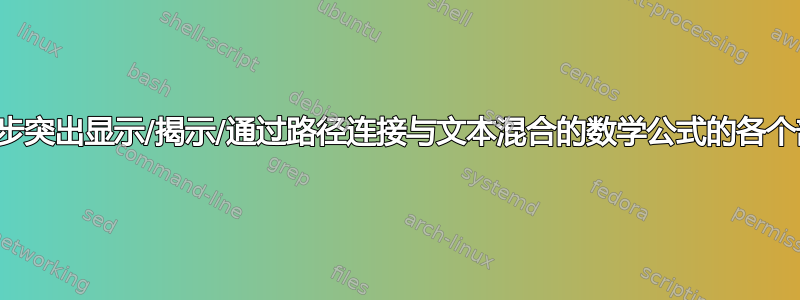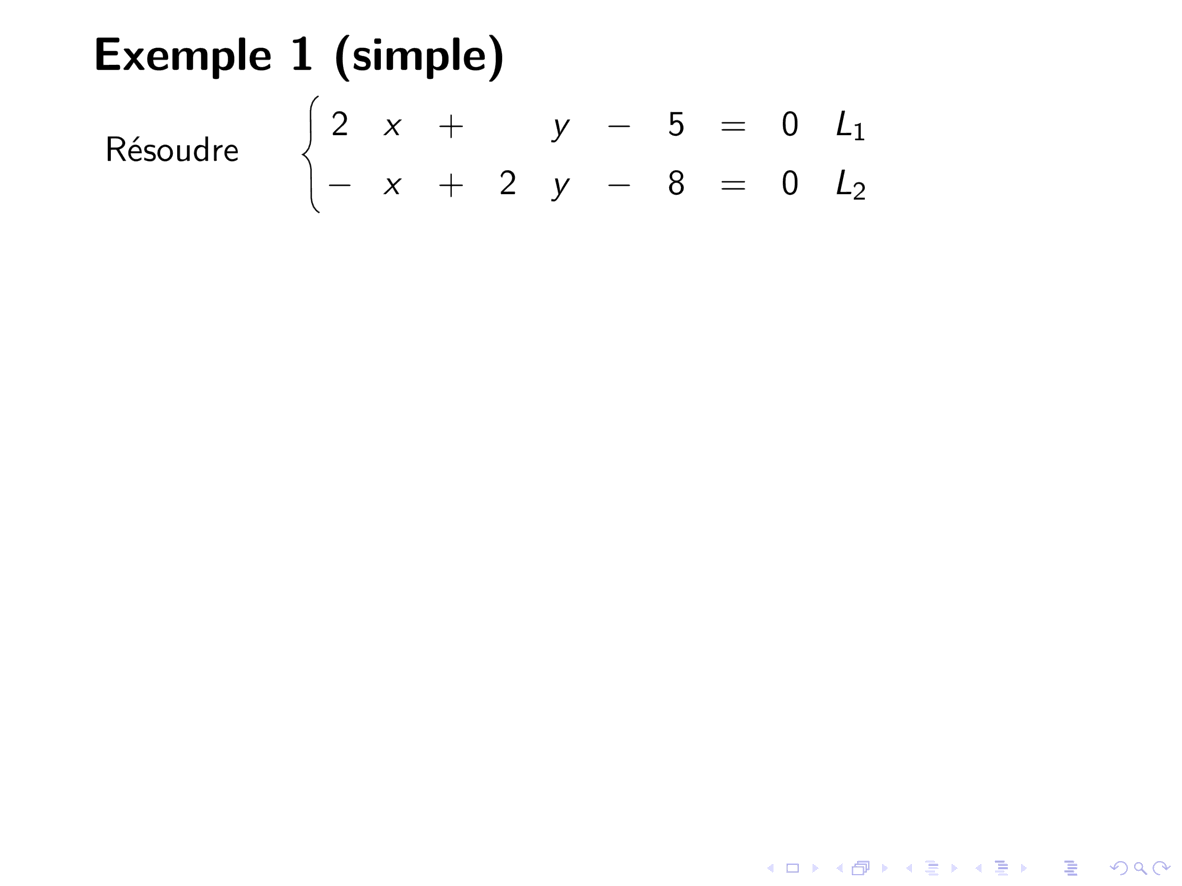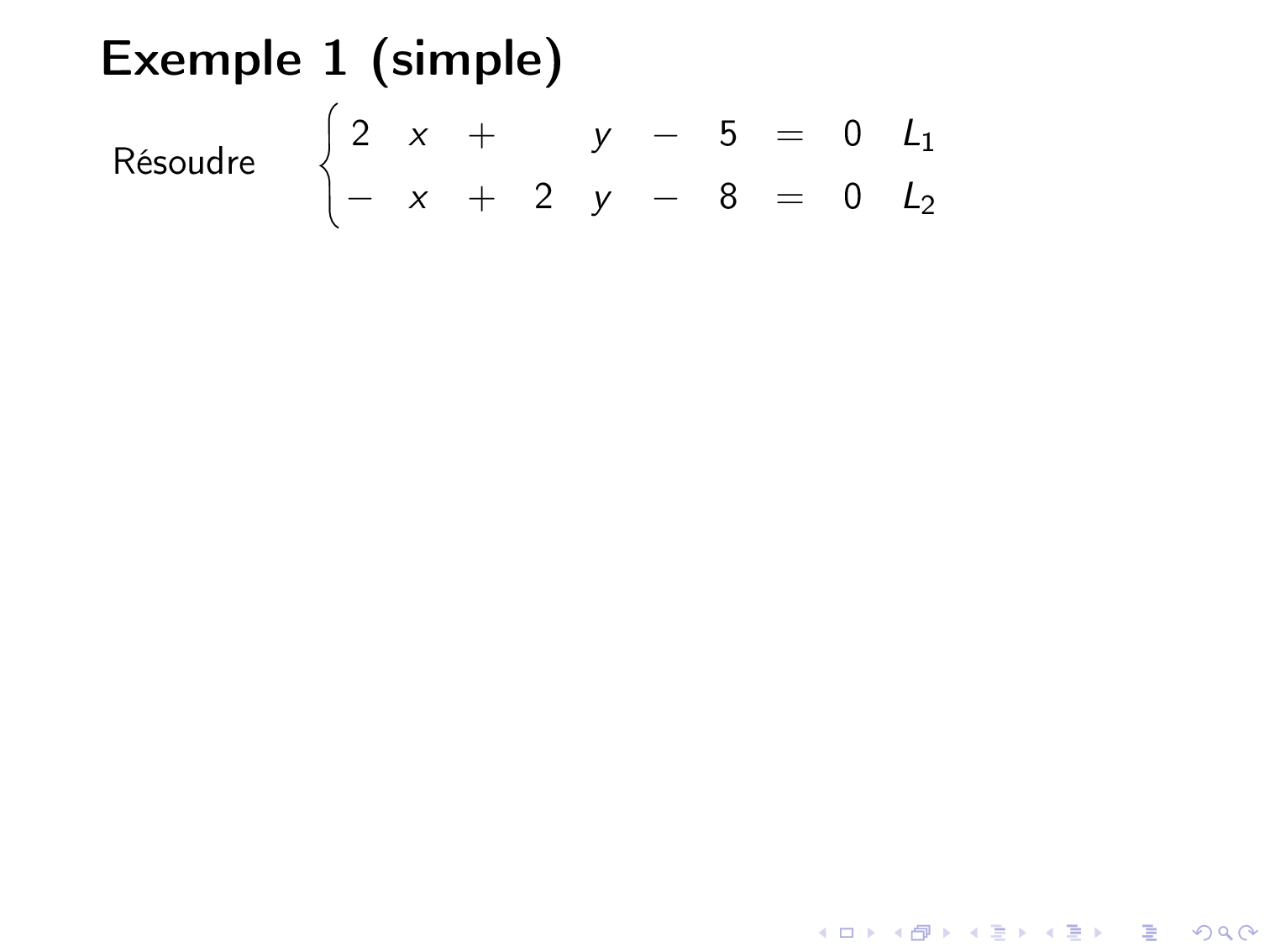
我编写了以下代码,它可以工作,并且大致可以完成任务。但它存在许多缺陷,我认为它很丑陋,并希望得到一些关于如何正确完成相同任务的建议!
\documentclass{beamer}
\usepackage{etex}
\usepackage[utf8]{luainputenc}
\usepackage[T1]{fontenc}
\usepackage[french]{babel}
\usepackage{amsmath, amssymb, ifthen, calc}
\hypersetup{pdfencoding=utf8}
\usepackage{pgfplots, tikz, xargs}
\usetikzlibrary{arrows, arrows.meta, bending, fadings, matrix, positioning, shadows, shadows.blur, shapes, shapes.misc, tikzmark}
\usetikzlibrary{overlay-beamer-styles}
\usetikzlibrary{matrix, fit, backgrounds, patterns, decorations.pathreplacing}
\begin{document}
\tikzstyle{every picture}+=[remember picture]
\begin{frame}[fragile]
\textbf{\Large Exemple 1 (simple)}
\tikzset{%
mes styles/.style={},
mes styles 1/.style={fill=white},
mes styles 2/.style={fill=green!20}}
\only<2-3>{\tikzset{mes styles/.style={mes styles 2}}}
\begin{tikzpicture}
\node[anchor=west] (R) at (0,0) {Résoudre} ;
\matrix[matrix of math nodes, nodes={minimum width=width("$-1$"), minimum height=1.5em}, align=left, column sep=-\pgflinewidth, row sep=-\pgflinewidth] at (5.5, -.5ex) (S1) {
|[mes styles]| $2$ & $x$ & $+$ & & $y$ & $-$ & $5$ & $=$ & $0$ & $L_1$\\
|[mes styles]| \alt<3>{\color{red}{$\!\!-1\!\!$}}{$\!-\!$} & $x$ & $+$ & $2$ & $y$ & $-$ & $8$ & $=$ & $0$ & $L_2$\\ % How to avoid moves (question related to node size)
} ;
\draw[decorate, decoration={brace, mirror, amplitude=5pt}] (S1-1-1.north west) -- (S1-2-1.south west) ;
\fill<4>[red, opacity=.2] (S1-2-1.south west) rectangle (S1-2-9.north east) ;
\uncover<4-6>{
\node[anchor=west] at (0, -2) {d'où} ;
\matrix[matrix of math nodes, nodes={minimum size=width("$-2$"), minimum height=1.5em}, ampersand replacement=\&, row 3/.style={visible on=<5->},
below=of S1.south east, anchor=north east, align=left, yshift=1cm] (S2) {
$\phantom{-}2$ \& $x$ \& $+$ \& \& $y$ \& $-$ \& $5$ \& $=$ \& $0$ \& $L_1$\\ % Why matrix of math nodes are not effective ? I need to add $...$
\alt<4>{\color{red}{$-2$}}{$-2$} \& $x$ \& $+$ \& $4$ \& $y$ \& $-$ \& $16$ \& $=$ \& $0$ \& $\color{red}2\color{black}L_2$\\
$\hphantom{-}0$ \& $x$ \& $+$ \& $5$ \& $y$ \& $-$ \& $21$ \& $=$ \& $0$ \& \rlap{$L_1+2L_2$} \\
} ;
\draw[decorate, decoration={brace, mirror, amplitude=5pt}] (S2-1-1.north west) -- (S2-2-1.south west) ;
\draw<5-9> (S2-3-1.north west) -- (S2-3-9.north east) ;
\uncover<5>{
\fill[green, opacity=.2] (S2-1-1.north west) rectangle (S2-3-2.south east) ; % Why different nodes heights (ok for the lower part of y, though) ?
\fill[cyan, opacity=.2] (S2-1-3.north west) rectangle (S2-3-5.south east) ; % I tried to set the height without success
\fill[blue, opacity=.2] (S2-1-6.north west) rectangle (S2-3-7.south east) ; % Why the colored blocks are overlapping by default ?
\fill[orange, opacity=.2] (S2-1-9.north west) rectangle (S2-3-9.south east) ; %
}
}
\fill<4>[red, opacity=.2] (S2-2-1.south west) rectangle (S2-2-9.north east) ;
\draw<4>[line width=4pt, red, -stealth] (S1-2-9.east) to [controls=+(-10:1) and +(0:1)] node[right] {$\pmb{\times 2}$} (S2-2-9.east) ; % How to use a transparency group to connect the two rectangular zone with a nice arrow ? I mean, how to blend it with various \uncover not happening all at the same moment ?
\uncover<7-10>{
\matrix[matrix of math nodes, nodes={minimum size=width("$-2$"), minimum height=1.5em}, ampersand replacement=\&,
below=of S1.south east, anchor=north east, align=left, xshift=5pt, yshift=1.3cm] (S3) {
\hphantom{-0} \& \hphantom{x} \& \hphantom{+} \& $5$ \& $y$ \& $-$ \& $21$ \& $=$ \& $0$ \& \rlap{$L_1+2L_2$}\hphantom{$L_1$} \\
} ;
} ;
\uncover<7-11>{
\matrix[matrix of math nodes, nodes={minimum size=width("$-2$"), minimum height=1.5em}, ampersand replacement=\&,
below=of S3.south east, anchor=north east, align=left, xshift=5pt, yshift=1.5cm] (S4) {
|[visible on=<11>]| $x$ \& |[visible on=<11>]| $=$ \& |[visible on=<11>]| $\dfrac25$ \& \hphantom{5} \& |[visible on=<10>]| et \& \hphantom{-} \& $y$ \& $=$ \& $\dfrac{21}5$ \& \hphantom{$L_1$} \\
} ;
} ;
\uncover<10>{
\node[anchor=west] at (0,-2.8) (S5) {
$2x+\dfrac{21}5-5=0$ d'où $2x+\dfrac{21}5-\dfrac{25}5=0$ d'où $2x=\dfrac45$ d'où $x=\dfrac25$.
} ;
} ;
\uncover<12>{
\node[] at (5.5,-2) {% How to position this text properly and relatively to other elements ?
Ce système a pour solution $x=\dfrac25$ et $y=\dfrac{21}5$.
} ;
} ;
\end{tikzpicture}
\pause
\begin{enumerate}
\small
\item On remarque qu'éliminer $x$ se fera simplement en multipliant $L_2$ par \tikzmarknode[minimum height=1em, inner sep=1pt, fill=green!20, fill on=<2-3>]{R3}{$2$}
et en additionnant $L_1$ et $L_2$ : \pause
le coefficient de $x$ dans $L_2$, qui vaut initialement \tikzmarknode[minimum height=1em, inner sep=1pt, fill=green!20, fill on=<3>, text=red, text on=<3>]{R4}{$-1$}, \pause
passera alors à \tikzmarknode[minimum height=1em, inner sep=1pt, fill=red!20, fill on=<4>, text=red, text on=<4>]{R5}{$-2$}, \pause
ce qui par sommation avec $L_1$ permettra d'éliminer l'inconnue $x$.\pause
\item On obtient alors une équation à une inconnue facile à résoudre : $5y-21=0$ \pause d'où $5y=21$ d'où $y=\dfrac{21}5$.\pause
\item On remplace alors $y$ par sa valeur dans $L_1$ ou $L_2$, au choix. \pause Comme $y$ figure seul dans $L_1$, sans coefficient, on choisit $L_1$.
\end{enumerate}
\end{frame}
\end{document}
以下是我遇到的问题:
- 我无法修复节点大小,因此存在一些不适当的“移动”(例如它是一个由四个部分组成的矩形(英文:花括号)和一些大小不同的彩色矩形(例如,因为 y 的下部)。
- 数学节点矩阵在 tikzpicture 环境中不起作用?
- 为什么我的彩色矩形有点重叠?
- 如何使用透明组以漂亮的箭头连接两个节点(如何将其与不同时发生的各种 \uncover 混合)?
- 如何正确对齐多个矩阵以及矩阵内部的元素?
- 如何减少标量和未知量之间的空间?
提前感谢任何帮助或建议!
答案1
回答我能理解的问题:
- 用于
alt=<3>{text=red}{}将第三张幻灯片上的文本变为红色。 math被matrix of math nodes杀死align=left。- 重叠来自
outer sep节点的 s。 - 再次,使用 eg
alt=<5>{opacity=0.2}{opacity=0}代替所有这些\uncover等等命令。 如果你的意思是填充的框不均匀:可以通过使用矩阵的边界而不是节点来解决,例如
\fill[green] (S2-1-1.west|-S2.north) 矩形 (S2-3-2.east|-S2.south) ;
最后一项我不明白。结果如下:
\documentclass{beamer}
\usepackage{etex}
\usepackage[utf8]{luainputenc}
\usepackage[T1]{fontenc}
\usepackage[french]{babel}
\usepackage{amsmath, amssymb, ifthen, calc}
\hypersetup{pdfencoding=utf8}
\usepackage{pgfplots, tikz, xargs}
\usetikzlibrary{arrows, arrows.meta, bending, fadings, matrix, positioning, shadows, shadows.blur, shapes, shapes.misc, tikzmark}
\usetikzlibrary{overlay-beamer-styles}
\usetikzlibrary{matrix, fit, backgrounds, patterns, decorations.pathreplacing}
\begin{document}
\tikzset{every picture/.append style={remember picture}}
\begin{frame}[fragile]
\textbf{\Large Exemple 1 (simple)}
\tikzset{%
mes styles/.style={},
mes styles 1/.style={fill=white},
mes styles 2/.style={fill=green!20}}
\only<2-3>{\tikzset{mes styles/.style={mes styles 2}}}
\begin{tikzpicture}
\node[anchor=west] (R) at (0,0) {Résoudre} ;
\matrix[matrix of nodes, cells={nodes={minimum width=width("$-1$"), minimum height=1.5em}},
align=left, %<-undoes math in matrix of math nodes
column sep=0pt,
row sep=-\pgflinewidth] at (5.5, -.5ex) (S1) {
|[mes styles]| $2$ & $x$ & $+$ & & $y$ & $-$ & $5$ & $=$ & $0$ & $L_1$\\
|[mes styles,alt=<3>{text=red}{}]| $\!-\!$ & $x$ & $+$ & $2$ & $y$ & $-$ & $8$ & $=$ & $0$ & $L_2$\\ % How to avoid moves (question related to node size)
} ;
\draw[decorate, decoration={brace, mirror, amplitude=5pt}] (S1-1-1.north west) -- (S1-2-1.south west) ;
\fill[red,alt=<4>{opacity=.2}{opacity=0}] (S1-2-1.south west) rectangle (S1-2-9.north east) ;
\begin{scope}[visible on=<4-6>]
\node[anchor=west] at (0, -2) {d'où} ;
\matrix[matrix of nodes,cells={nodes={minimum size=width("$-2$"), minimum height=1.5em,outer sep=0pt}}, %<-outer sep fixes overlap
ampersand replacement=\&, row 3/.style={visible on=<5->},
below=of S1.south east,xshift={width("$2L_2$")-width("$L_2$")}, anchor=north east, align=left, yshift=1cm,
column sep=0pt] (S2) {
$\phantom{-}2$ \& $x$ \& $+$ \& \& $y$ \& $-$ \& $5$ \& $=$ \& $0$ \& $L_1$\\ % Why matrix of math nodes are not effective ? I need to add $...$
\alt<4>{\color{red}{$-2$}}{$-2$} \& $x$ \& $+$ \& $4$ \& $y$ \& $-$ \& $16$ \& $=$ \& $0$ \& $\color{red}2\color{black}L_2$\\
$\hphantom{-}0$ \& $x$ \& $+$ \& $5$ \& $y$ \& $-$ \& $21$ \& $=$ \& $0$ \& \rlap{$L_1+2L_2$} \\
} ;
\draw[decorate, decoration={brace, mirror, amplitude=5pt}] (S2-1-1.north west) -- (S2-2-1.south west) ;
\draw<5-9> (S2-3-1.north west) -- (S2-3-9.north east) ;
\end{scope}
\begin{scope}[alt=<5>{opacity=0.2}{opacity=0}]
\fill[green] (S2-1-1.west|-S2.north) rectangle (S2-3-2.east|-S2.south) ; % Why different nodes heights (ok for the lower part of y, though) ?
\fill[cyan] (S2-1-3.west|-S2.north) rectangle (S2-3-5.east|-S2.south) ; % I tried to set the height without success
\fill[blue] (S2-1-6.west|-S2.north) rectangle (S2-3-7.east|-S2.south) ; % Why the colored blocks are overlapping by default ?
\fill[orange] (S2-1-9.west|-S2.north) rectangle (S2-3-9.east|-S2.south) ; %
\end{scope}
\fill<4>[red, opacity=.2] (S2-2-1.south west) rectangle (S2-2-9.north east) ;
\draw<4>[line width=4pt, red, -stealth] (S1-2-9.east) to [controls=+(-10:1) and +(0:1)] node[right] {$\pmb{\times 2}$} (S2-2-9.east) ; % How to use a transparency group to connect the two rectangular zone with a nice arrow ? I mean, how to blend it with various \uncover not happening all at the same moment ?
\matrix[visible on=<7-10>,matrix of math nodes, nodes={minimum size=width("$-2$"), minimum height=1.5em}, ampersand replacement=\&,
below=of S1.south east, anchor=north east, align=left, xshift=5pt, yshift=1.3cm] (S3) {
\hphantom{-0} \& \hphantom{x} \& \hphantom{+} \& $5$ \& $y$ \& $-$ \& $21$ \& $=$ \& $0$ \& \rlap{$L_1+2L_2$}\hphantom{$L_1$} \\
} ;
\matrix[matrix of math nodes, nodes={minimum size=width("$-2$"), minimum height=1.5em}, ampersand replacement=\&,
below=of S3.south east, anchor=north east, align=left,
xshift=8pt, yshift=1.5cm,
visible on=<7-11>] (S4) {
|[visible on=<11>]| $x$ \& |[visible on=<11>]| $=$ \& |[visible on=<11>]| $\dfrac25$ \& \hphantom{5} \& |[visible on=<10>]| et \& \hphantom{-} \& $y$ \& $=$ \& $\dfrac{21}{5}$ \& \hphantom{$L_1$} \\
} ;
\node[anchor=west,visible on=<10>] at (0,-2.8) (S5) {
$2x+\dfrac{21}5-5=0$ d'où $2x+\dfrac{21}5-\dfrac{25}5=0$ d'où $2x=\dfrac45$ d'où $x=\dfrac25$.
} ;
\node[visible on=<12>] at (5.5,-2) {% How to position this text properly and relatively to other elements ?
Ce système a pour solution $x=\dfrac25$ et $y=\dfrac{21}5$.
} ;
\end{tikzpicture}
\pause
\begin{enumerate}
\small
\item On remarque qu'éliminer $x$ se fera simplement en multipliant $L_2$ par \tikzmarknode[minimum height=1em, inner sep=1pt, fill=green!20, fill on=<2-3>]{R3}{$2$}
et en additionnant $L_1$ et $L_2$ : \pause
le coefficient de $x$ dans $L_2$, qui vaut initialement \tikzmarknode[minimum height=1em, inner sep=1pt, fill=green!20, fill on=<3>, text=red, text on=<3>]{R4}{$-1$}, \pause
passera alors à \tikzmarknode[minimum height=1em, inner sep=1pt, fill=red!20, fill on=<4>, text=red, text on=<4>]{R5}{$-2$}, \pause
ce qui par sommation avec $L_1$ permettra d'éliminer l'inconnue $x$.\pause
\item On obtient alors une équation à une inconnue facile à résoudre : $5y-21=0$ \pause d'où $5y=21$ d'où $y=\dfrac{21}5$.\pause
\item On remplace alors $y$ par sa valeur dans $L_1$ ou $L_2$, au choix. \pause Comme $y$ figure seul dans $L_1$, sans coefficient, on choisit $L_1$.
\end{enumerate}
\end{frame}
\end{document}




